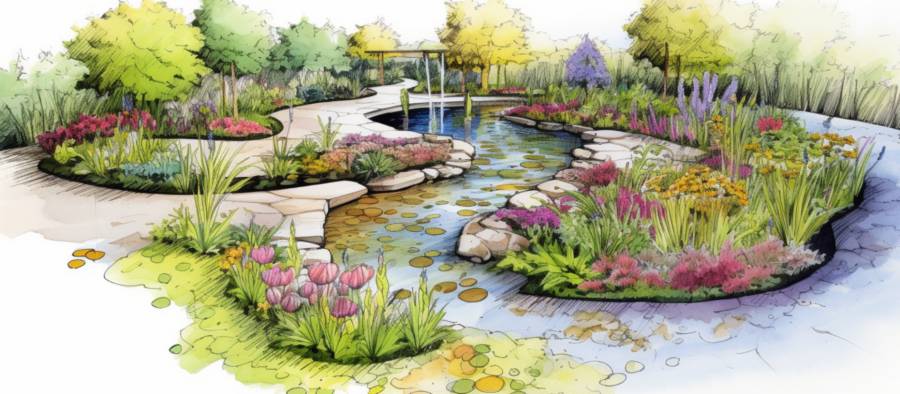Rain Gardens: Combating Runoff and Beautifying Yards

Why Should You Care About Rain Gardens?
Picture it: you're sipping a cup of tea (or perhaps something stronger) while gazing out at your backyard. Suddenly, the skies open up and rain begins to fall. As you watch the water course through your yard, you may find yourself thinking, "Surely, there must be a better way to manage all this runoff!" Well, my friend, allow me to introduce you to the glorious world of rain gardens.Rain gardens are not just a fashionable landscaping trend. They are a practical and environmentally-friendly solution to water runoff problems. Designed to capture and absorb water efficiently, rain gardens help prevent pollutants and excess nutrients from entering our rivers, lakes, and groundwater. But the benefits don't stop there; they also add beauty to your property, create habitat for wildlife, and can even increase your property value. So why not roll up your sleeves and dive headfirst into the delightful realm of rain gardens?
Designing the Perfect Rain Garden
First things first: location, location, location! The ideal spot for your rain garden is one that is both downhill from your home and at least ten feet away from the foundation. This will help keep water from seeping into your basement or causing other structural damage.Now, let's talk size. The size of your rain garden should be determined by the amount of runoff you're trying to capture. As a general rule of thumb, a rain garden should be about 20-30% the size of the area draining into it. For example, if you have 1,000 square feet of roof area draining into your garden, you'd want it to be 200-300 square feet in size.
Next up: depth. The ideal depth for a rain garden is about four to eight inches, depending on the soil type and infiltration rate. If you have clay or compacted soil, you may need to excavate deeper to improve drainage. Be sure to create a slight slope, or berm, around the edges of your garden to help contain and direct water flow.
Choosing Plants for Your Rain Garden
When selecting plants for your rain garden, think native and water-loving. Native plants are well-suited to your local climate and soil conditions, require less maintenance, and provide habitat for local wildlife. Water-loving plants, also known as hydrophytes, are adept at tolerating both wet and dry conditions, perfect for a rain garden environment.Consider planting your rain garden in tiers, with plants grouped according to their water needs. Place moisture-loving plants in the center, where the garden will be deepest and wettest, and drought-tolerant plants on the outer edges, where the soil will be drier.
- Moisture-loving plants: Joe-Pye weed, cardinal flower, swamp milkweed, blue flag iris
- Medium moisture plants: New England aster, black-eyed Susan, goldenrod, switchgrass
- Drought-tolerant plants: butterfly weed, coneflower, coreopsis, little bluestem
Maintaining Your Rain Garden
Once your rain garden is established, it will require minimal maintenance. Watering should only be necessary during the establishment phase or during extended periods of drought. Be sure to keep an eye on your plants, as they may require some pruning or deadheading to keep them looking their best.One important maintenance task is to monitor the infiltration rate of your rain garden. If you notice that water is not draining as quickly as it should, you may need to add more plants, increase the size of your garden, or amend your soil.
The Pinnacle of Puddles
By now, you may be positively brimming with enthusiasm for rain gardens and eager to get started on your own. Rest assured that your efforts will be rewarded with not only a beautiful yard but also a healthier environment for your community. Rain gardens are a shining beacon of hope in a world plagued by water runoff issues, a testament to the power of nature and human ingenuity. Embrace the rain and let your garden flourish, for you are now a proud member of the rain garden revolution! Cheers!Article kindly provided by yourhomengarden.org
Latest Articles
- Why Damp Feels Worse in Some Rooms Than Others
- The Hidden Health Benefits of a Deep Clean
- Uncommon Ways to Estimate Waste Volume Before a Cleanup Project
- How to Spot and Tackle Hidden Moisture Problems Before They Become Renovation Nightmares
- How Underground Pipe Issues Can Lead to Structural Damage
- Simple Design Tricks That Encourage Backyard Biodiversity
- Why Your Showerhead Is Suffering From a Mineral Midlife Crisis
- Gateways That Turn Heads While Keeping Your Property Safe
- Listening Pipes: Using Sound to Diagnose Hidden Home Plumbing Issues
- Small Changes That Make a Kitchen Feel Completely New
- Scents That Refuse to Leave and How to Outwit Them
- How Personalisation Makes Homewares Feel Special
- Asphalt Advantage and the HOA Budget Balancing Act
- The Step-By-Step Process of Turning a Garden Vision into Reality
- Rain Doesn't Fall Straight: Why Roof Shape and Wind Matter More Than You Think
- How Fire Pit Design Quietly Shapes Human Connection
- Invisible Passengers Who Never Pay the Fare
- When the Ground Has Opinions: Learning to Hear Tree-Soil Conversations
- When Windows Sweat: What Condensation Reveals About Your Home's Hidden Climate
- Vertical Micro-Oasis for Kitchen Herbs in Tight Urban Spaces
- Interior Design
- Home Improvement
- Gardening
- Home Organization
- Home Maintenance
- DIY Crafts
- Kitchen and Dining
- Bathroom Design
- Home Security
- Home Automation
- Green Living
- Home Office
- Home Decor
- Garden Design
- Pet Care
- Home Technology
- Landscaping
- Home Energy Efficiency
- Home Cleaning
- Home Safety
- Home Exterior
- Home Insulation
- Home Buying
- Home Selling
- Renting
- Tradespeople
- Garage
- Bedroom
- Painting and Decorating
- Plumbing and Drainage

